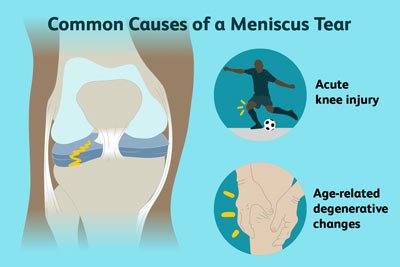Professional athletes keep doctors on speed dial for a variety of injuries. Knee injuries are one of the most common. Now you too have an experienced pain doctor near you to provide the same level of professional treatment for knee problems, including a torn meniscus. If you jog frequently or play contact sports, the best injury doctors in New York are at pain management NY. Whether you need emergency care or suffer from long-standing knee pain, don’t wait to get an accurate diagnosis and quick relief. Call today for an appointment.
Your knee is one of the largest joints in your body, and if you’re active, you continually put it in stressful activities, such as jumping, running and squatting. One of the most frequently experienced knee injuries is a meniscus tear because it’s an injury that can happen at any age. When individuals mention having torn cartilage in the knee, a torn meniscus is the injury they’re usually talking about.
Each knee has two menisci, which are C-shaped pieces of cartilage that serve as a cushion and a shock absorber between your thigh bone, the femur, and the larger of your shin bones, the tibia. Stiffness, pain and swelling in your knee may be signs of a meniscus tear. If you think you may have a torn meniscus, see the experts at pain relief center New York for an accurate diagnosis followed by effective meniscus tear treatment.
Symptoms of a Meniscus Tear
A torn meniscus causes knee pain. The location of the pain depends on the part of your knee you’ve hurt. Remember, you have two menisci. If the tear affects the inside of your knee joint, it’s called a medial meniscus tear, while a tear affecting the outside of the joint is called a lateral meniscus tear. Symptoms of a meniscus tear include:
- Stiffness or swelling in your knee
- Worsening pain when rotating or twisting your knee
- Difficulty straightening or fully extending your leg
- Locking or catching of the knee joint
- Hearing or feeling a popping sensation
- Sensation of instability or a feeling of your knee giving way under you

Most people are still able to walk after a meniscus tear, but you may find that you’re walking with a limp. The symptoms of a meniscus tear so resemble several other types of knee injuries — such as a ligament tear or tendonitis — that you must see a top pain management specialist in NYC for an accurate diagnosis. At Pain Management NYC, top pain doctors rely on the most advanced diagnostic equipment to ensure speedy and accurate findings so they can begin the appropriate regenerative treatment.
Causes and Risk Factors for a Torn Meniscus
Athletes — particularly those who participate in sports that require a lot of jumping, pivoting or knee rotation — are at high risk of experiencing a meniscus tear. Basketball, tennis and football are sports that often lead to these injuries. Squatting frequently, twisting the knee awkwardly or a hard blow to the knee can cause a sudden tear.
As you age, you’re at a greater risk of having a degenerative meniscus tear. That’s because, as part of the aging process, your cartilage becomes thinner and worn down. You may experience a meniscus tear from a simple movement, such as getting out of a chair. Your meniscus may tear unexpectedly even when there’s been no trauma or sudden movements. Once you’ve had a meniscus tear, you’re at a higher risk of developing osteoarthritis in the affected knee, which requires a different type of treatment.
Treatment for a Meniscus Tear
Meniscus tears can vary widely in severity and size. It’s important to catch it early to prevent further complications. Without treatment, a piece of the cartilage may come loose and drift into the joint, causing a locked knee. Emergency appointments are available at the top-rated pain clinic in Manhattan. If you have an accident or sudden pain that could indicate a torn ligament, don’t delay in seeking medical help.
The initial part of treatment for a meniscus tear is to avoid any activities that cause knee pain. Rest, elevation and ice, along with wearing an elastic compression bandage, may help to reduce knee pain and swelling once your pain doctor has determined that you have a minor tear. Other recommended treatment options include:
- Physical therapy. This form of interventional treatment strengthens the muscles in your leg and around your knee, which can help stabilize the knee joint.
- Knee arthroscopy. This is a minimally invasive procedure in which your meniscus may be repaired or removed. This outpatient procedure doesn’t require a lengthy recovery.
- Corticosteroid injections. Knee injections provide sufficient pain relief so that you can participate fully in therapeutic treatments and get back to your normal routines more quickly.
With proper diagnosis and treatment of a meniscus tear, you can return to the same level of ability you had before your injury. If you have a knee injury and believe you’ve torn your meniscus, contact the doctors at Pain Management NYC for the best pain management in Manhattan. You’ll receive the best care from doctors who put your needs first.

Boleslav Kosharskyy, MD, is a top-rated, best-in-class interventional pain management doctor. He is board-certified in Anesthesiology, Interventional Pain Medicine, and Palliative Care.
Dr. Kosharskyy is an Associate Professor of Anesthesiology and Rehabilitation Medicine at Albert Einstein Medical College. He’s also the Associate Medical Director of Pain Medicine and Director of Anesthesia for the Joint Replacement Center at Montefiore Medical Center and Albert Einstein Medical College.
He is an active member of the American Society of Anesthesiology (ASA), the American Society of Regional Anesthesia and Pain Medicine (ASRA), and the New York State Society of Anesthesiologists (NYSSA)
